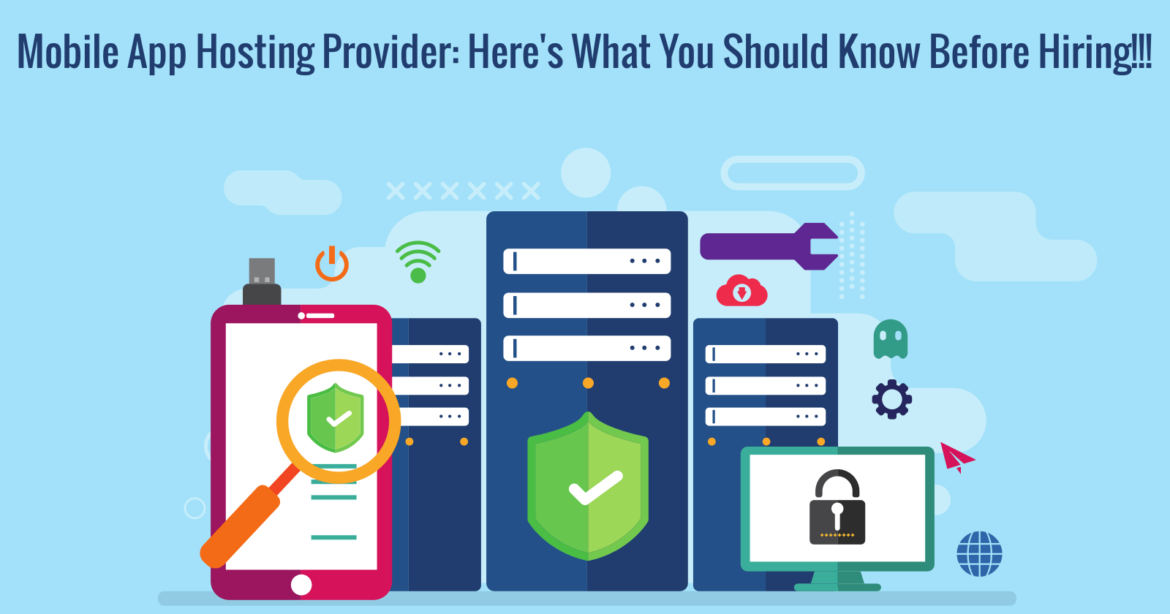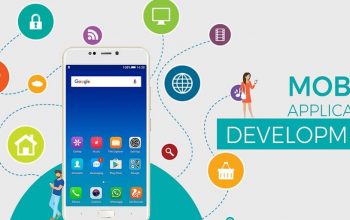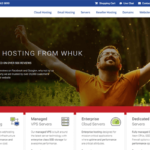Why speak the APP for your mobile app hosting?
A graphical representation of how the backend of the mobile app performs
These days, would you reach out to a wide client base without a smartphone app? Well, with your business, you do need your website, but mobile apps are now much too relevant. As App Annie’s State of Mobile 2020 study reveals, Internet consumers invested 35 percent more time on their mobile devices in 2019 relative to 2017.
Google Play had 3.3 million Android applications as of September 2019, while the Apple App Store had 2.2 million iOS products. For more such mind-boggling numbers, read “App stores list (2019)” yet, you can see why mobile apps are critical!
You certainly don’t need me to clarify why when you launch a smartphone app, a simple “Time to market” is critical, do you? Early movers, after all, enjoy multiple benefits, and for your mobile app you will certainly want to do that!
This is where the mobile backend and hosting problems achieve relevance. You need a plan to concentrate on front-end growth, as I mentioned in “10 greatest challenges when creating an app,” so you need support with the backend. Let ‘s dig more deeply.
What are the choices for handling the backend of smartphone apps?
After we’ve found out what the backend is and why you need it, it’s time to explore how to host a smartphone app and all the backend peculiarities that come with it. An entirely separate ball game from front-end creation is the creation of the backend of mobile applications. For starters, you and your team must have the following expertise:
- Network technology, site servers included;
- Control of Databases;
- Programing on the server-side;
- Classic security-assuring cryptography;
- Big Data;
- Network for Mobile Telecommunications.
But, all this poses another issue, that of hosting for the creation of software.
You have options for total mobile app backend maintenance, and these are as follows:
- You may depend on and use their support from a ‘Mobile Backend as a Support’ (MBaaS) provider. It’s the cheapest alternative, the hosting is done by the vendor, and a shorter ‘time-to-market’ is likely to be encountered. In How To Pick The Right Smartphone Backend As A Service (MBaaS), learn all about it? ”.
- You may use existing software and frameworks used by certain cloud service companies to code the mobile backend, for example. Google, bid, bid. It is not as straightforward as the previous alternative, but at least you have market-leading offerings that you can rely on. Your hosting concerns are handled by the Cloud service provider.
- For you to code the whole backend to find a provider who will host the mobile app is the toughest choice. Besides being a long process, this choice involves a broad range of skills. You should recommend it if you need a large option of customization and have the requisite experience in your squad.
MBAAS: the easiest choice for hosting the backend of your mobile app.
MBaaS companies exploit the “as-a-service” paradigm of cloud computing, where you utilize their service when maintaining your mobile backend. You will be given the following by a strong MBaaS provider:
- Safe and Storage Infrastructure;
- APIs, based on the criteria of the app, like social networks and many others;
- Ability to access disparate mobile channels and applications seamlessly;
- Authenticating and handling users;
- Storage of permanent data;
- Notification through push;
- Products for Geolocation;
- About analytics;
- Capability to exploit architecture for microservices;
- Ease of usage and superb service for consumers.
PROVIDERS MBAAS COMPARED
An image of a laptop in the background with logos in the foreground from various MBaaS providers
You have several MBaaS provider options, as follows:
Google Firebase: In 2016 , Google purchased Firebase and joined the MBaaS domain. The following types of resources are provided by Firebase:
- ‘Develop’ requires a network for the internet, user verification, messaging and safety. It also provides hosting, resources for checking, and features for crash notification.
- The ‘Grow’ service segment enables you to evaluate customer experiences, including analytics, indexing, and interactive linking.
- For ads,’ receive’.
They’ve got a free rate, and you’re paying below the threshold.
AWS Amplify: This is AWS’s MBaaS bid. In addition , it uses the excellent cloud capabilities of AWS, providing a full range of functionality that an MBaaS framework might provide. You can use it to build mobile apps that are both native and hybrid, and AWS Amplify makes it easy for your app to scale. Key features such as encryption, account control, account verification, “push alerts”, etc. would be simple to introduce. In the mobile app development workflow, AWS Amplify covers the entire set of activities, e.g., version control, testing , deployment, etc. APIs can be quickly integrated, and you can even store data safely. In addition, AWS Amplify includes a full collection of resources to access its open-source repositories, CLI, etc. For more insights, read the’ Amplify Framework’ documentation on GitHub.
Apple CloudKit: This is the MBaaS offering for Apples. It provides most resources for MBaaS and is really useful for the production of your iOS applications. It’s also fine if you build basic software, but they don’t help the execution of server-side logic, and on the client side, developers need to run application logic. You pay as you hit the free-tier mark.
In their 2018 Magic Quadrant 2018 report, Kinvey: Gartner acknowledges them as a “Visionary” and it is justified because of the broad set of services they provide. Their ready-made software models are really useful, in addition to the usual MBaaS features. Their supply of analytics is rich, while with their SDKs you can create native, hybrid, and IoT applications.
AWS: MBaaS from Amazons offers a diverse range of offerings spanning the full spectrum of MBaaS. Amazon Cloud is outstanding, and when you use their service, it is an advantage. They also have a free level; the AWS MBaaS is not easy to use, however. So, how much does hosting an app on AWS cost? The simplest answer would be that it depends on the number of users that your app has. Like we’ve said, there’s a free server that can be used to host a mini-site or a tiny app for 1 year, after that the price is $8-10 a month, so once you have more customers, the price increases dramatically, and it can be as big as $5,000 a month for major startups and businesses.
SashiDo: Several developers of mobile backends were major fans of Parse, a provider of MBaaS that closed in 2017. SashiDo’s major benefit is that it’s developed on and functions like the Parse open-source technology. Their products span the whole MBaaS spectrum, and while they do not have a free tier, their customer support is outstanding.
Kumolos: Although all regular MBaaS features are offered, their software is better suited to businesses creating smartphone applications. To monitor developments for their mobile app, Kumolos provides a consumer platform that consumers of the app production business use. An organization console that helps software production businesses to control their portfolio is also provided by this MBaaS provider.
Learn our “Why to pick the right smartphone backend as a service (MBaaS)” overview of MBaaS providers?? “For additional details.
HOSTING A BACKEND Utilizing READY-MADE Software FOR YOUR MOBILE APPLICATION: THE “East” Alternative
I’m now going to clarify the alternative between depending solely on an MBaaS provider and coding the whole backend yourself. While MBaaS is a nice option for your mobile application to host a backend, there are times when you need greater flexibility.
I’ll explain how you can use the Google Cloud service in this section, and build your backend using their ready-made tools. I discussed earlier how you can use Google Firebase resources for your backend, so let’s take this as the starting point.
While you can easily start with Firebase and rapidly bring your mobile app to life, you might have a more complicated requirement. For starters, you need more customization choices if your app wants to edit synchronized data.
Ordinary ecosystem with Firebase and Google Software Engine
A ‘Application as a Service’ (PaaS), which can track, scale and upgrade the hosting environment, is the Google App Engine standard environment. You bring your code and data, as with the Cloud computing PaaS model.
For the backend of your mobile app, that means you need to code the backend. Read more in their Google Cloud document repository about the App Engine standard environment.
Here, I suggest that you expand Firebase instead of coding your mobile backend from scratch. It provides you with real-time data synchronization automatically. While synchronized data can now be updated by your app, what if you need a higher customization level?
For eg, do you need:
- Call or write to a file system utilizing native binaries?
- Have a continuous Firebase connection?
- Allow other calls to the system?
Now, there’s more customization required. Just read on!
Web App Backend with a scalable environment for Firebase and Google App Engine
An airplane engine sketch that is a Google Search Engine emblem
The versatile Google App Engine framework offers you more opportunities for customization than the regular environment. It does everything that can be achieved in the normal setting, but uses Docker containers.
You should customize it because it operates the backend service within the jar. In ‘WHAT IS A CONTAINER’, learn all about Docker pods.
This allows native binaries to be called, write to file systems, or make other system calls. Find out more about the open environment for the App Engine in their documents archive for Google Cloud services.
But with this move you’ve personalized more, what if you want more customization? In order to find out what you should do to create client libraries automatically, read on. To call the backend directly, the app may use them.
For your android app hosting, Google Cloud Endpoints and Google App Engine
Using the database libraries that Cloud Endpoints creates, your mobile app will allow direct API calls. To facilitate communication with the App Engine, you don’t need to write code. As before, being a PaaS, the Software Engine manages hosting, scaling, tracking, etc.
When you transfer data to cloud servers, this method also helps you to reduce the storage of information on a mobile computer. Additionally, push alerts are allowed by the Cloud messaging program. In its’ Google Cloud documentation, you can read about Google Cloud Endpoints.
So, you’ve personalized more, and that’s amazing! You can’t use this strategy, though, because if your software wants to do the following, you need to personalize more:
- Synchronization of automatic and real-time data between mobile devices;
- Backend services that include custom servers or 3rd party services;
- Link without SSL to systems.
HOSTING MOBILE APP IN the ‘DO-IT-YOURSELF’ way
On a continuum in which we started using an MBaaS, we are progressing. We had no customization choices, so we switched to Google App Engine, where we had more customization options, such as PaaS. If your criteria for customization are greater, than you need a ‘Do-It-Yourself’ (DIY) technique.
It’s the toughest way to tackle the specifications for the backend, where you need to create the own backend and even locate mobile app hosting providers. It’s a complicated project, and recommend seeking expert support if you don’t have the requisite backend growth, technology, and protection expertise in your team.
For mobile backend growth, select the required technology stack
You need to choose the right software stack for development, don’t you? Here, there are two key choices, namely, creation of hybrid apps and creation of native apps.
Which one do you pick? The creation of hybrid software helps you to build a smartphone app with a single code base for both Android and iOS. This keeps the cost of development down, and you only need to keep one code base. Modern architectures for hybrid software creation such as React Native include near-native “user experience” (UX).
Well, “near-native” was the key operative word above, and that makes a difference! Because you code them using programming languages that are uniquely built for the respective devices, native apps deliver the strongest UX. “They also offer the best performance and security, as I explained in” What is the best approach to development to guarantee your app’s success? ”.
I advise you to emphasize UX and create native applications. You can use the programming languages below:
Kotlin for the creation of native Android: Java has long been the mainstay of the creation of native Android, and it doesn’t require an introduction. Kotlin has, however, emerged in recent years as a common option for native Android creation, and I suggest that you use it. Kotlin has lightweight modules, so it helps you to code extremely powerful applications. It can be quickly mastered by native Android developers with Java expertise, and Kotlin has excellent features to prevent typical coding errors. Read our “Kotlin vs Java: Which one is the right choice?” guide. “In order to hear more about it.
Swift for native iOS development: Objective-C was historically the base for native iOS development, however in recent years, Swift has achieved tremendous prominence. It’s a modern language with strong characteristics, and with it you can prevent typical coding mistakes. Your codebase, which allows management simpler, stays manageable enough. Swift helps you to write programs that are powerful and scalable, and I suggest you use it. In “Why to migrate your Objective-C project to Swift?”, I clarified its benefits. ”.
Ok, we’ve covered programming languages, but you want to scale up the method of growth, don’t you? In order to reach the back-end, you would also need to create a standardized structure for your front-end, so I suggest that you develop APIs.
The de-facto standard for API creation is “REST” (Representational State Transfer), so I suggest that you build RESTful APIs. Careful preparation, utilizing the correct instruments, tracking the APIs, storing them on a cloud server, and securing them involves API growth. Require API production assistance? Our “How to Create Your Mobile App RESTful API” guide? ‘That’s exactly what you like!
For API growth, you will need to use suitable database solutions, so I suggest the following:
- PostgreSQL: This is a widely popular “Relational Database Management System” (RDBMS) open source.
- MongoDB: If a text store has to be utilized, then a NoSQL database such as MongoDB is an ideal alternative. It’s incredibly scalable.
Pick a hosting service for mobile app servers
Once again, you have a broad range of hosting services for smartphone applications. I propose that you review the following, but it’s not an comprehensive list:
Amazon EC2: The “Infrastructure as a Service” (IaaS) product from AWS is Amazon Elastic Compute Cloud (EC2). It uses AWS ‘s robust cloud infrastructure capabilities, and its customers may use multiple APIs to provide infrastructure, storage , and networking easily. Amazon EC2 offers stable and resizable cloud storage ability.
Microsoft Compute Engine: This is the Cloud offering for ‘Infrastructure as a Service’ (IaaS) from Google. Digital machines can be built and operated. With strong scalability, efficiency, and value for your money, they offer dependable service. Using REST and gRPC protocols, you can link your app to your Compute Engine instances. For more details, search the Google Compute Engine document repository for really good documents.
IBM Cloud: Previously referred to as SoftLayer, IBM Cloud offers both bare metal and virtual server solutions for you. With all the main parameters that you might think about, such as network , data transmission, bandwidth, management, tracking, and customer service, IBM Cloud is competitive. For further info, visit the IBM Cloud page.
Digital Ocean: You can find it convenient to deploy virtual computers with them, another leading IaaS provider. The organization has a strong process for rollout, scaling, control, tracking, and security, processes , and resources (PM&T). To learn more about them, search the Interactive Ocean page.
Rackspace: They provide experience in all major cloud systems, both as a cloud storage company and as a controlled cloud service provider. The 2018 Gartner Magic Quadrant acknowledges them as a pioneer of service providers managed through public cloud technology. Find out details on the Rackspace page about them.
Additional resources to remember as mobile applications use a custom backend api
In the DIY method, you will even have to explore additional resources depending on your app, as follows:
- ‘Content Distribution Network’ (CDN): Do you have a number of downloadable assets, such as photos and videos, in your app? You are possibly dreaming of saving them for your cloud provider.
- To make downloading easier for your app consumers, you can explore using a CDN.
- CDNs help to distribute information efficiently when they duplicate it through different places.
Nice options for you are Incapsula, CDN77, Liquid Network, and Rackspace, but there are more options.
In “List of 17 Best CDN Service Providers of 2018: Revised Ratings”, learn more regarding CDNs and strong CDN providers.
Orchestration: Suggest a successful orchestration set-up if you need several servers for your mobile app backend. You will boost the efficiency as these platforms simplify the rollout, scaling, and maintenance of cloud infrastructure through several servers. A strong choice is Kubernetes. “A successful orchestration choice is Docker Swarm. Learn more about it in” What is Docker Swarm? A debate on orchestration of containers & future solutions.’
I suggest that you thoroughly evaluate the criteria. If your focus is ‘Time-to-Market’, you are best off hosting your mobile app backend with an MBaaS. In the other hand , suggest the middle path or the DIY solution I have mentioned, but if you can’t cope with customization, prepare to cope with more difficulty.
QUESTIONS Often Asked
Where to host the backend for a smartphone app?
The response to this query depends on the type of program you are designing and the criteria for success vs. expense, etc. You can submit the product details to DevTeam. Space to communicate with a professional for a concise response.
How to create a backend for a smartphone app?
Create a team of expert developers from mid to senior stage. Offer them the requirements of the project and prepare for them the growth splints. They should be able to build your smartphone backend with the necessary instructions.
What is the runtime framework for smartphone apps?
A web server, an application server, and a storage form the traditional backend architecture.








